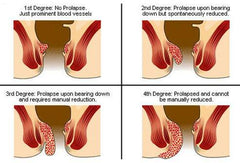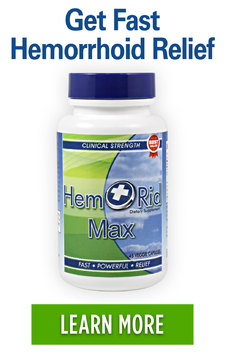What Are Hemorrhoids Like? Hemorrhoid Symptoms, Causes, Treatment and Remedies
Posted on 04 February 2018 by Maryanne Johnson
Share this post
What Are Hemorrhoids like? The most common thoughts that come to mind when you hear the word hemorrhoids are probably ones of discomfort, embarrassment, and pain involving the rectum.
The truth is that everyone has hemorrhoids. Hemorrhoids are the pillow-like group of veins that lie in the lower part of the rectum and the anus.
Their purpose is to keep stool from leaking out of the rectum. It is what happens to these veins when they become swollen, however, that most people refer to as hemorrhoids. Let’s take a closer look.
What Are Hemorrhoids Caused From?
Hemorrhoids, also called piles, develop when the cluster of veins that lie beneath the mucous membrane lining of the lower part of the rectum become swollen and distended. When these veins become enlarged, they can become irritated, painful, and cause a great deal of discomfort.
The most common causes of hemorrhoids are ones that increase pressure within the hemorrhoids blood vessels. These include:
- Straining during a bowel movement which puts excess pressure on the anal canal.
- Chronic constipation (1)
- Chronic diarrhea
- Prolonged sitting or standing
- Lack of exercise
- Poor diet, especially one that is low in fiber. This can lead to hardened stool that is difficult to pass and constipation. (2)
- Obesity
- Pregnancy
- Family history of hemorrhoids
- Age
What Are the Symptoms of Hemorrhoids?
There are a variety of symptoms associated with hemorrhoids. The presence of these symptoms depends on what type of hemorrhoid you are dealing with and the severity of your particular case.
Symptoms of hemorrhoids may include:
- Intense itching around the anus
- Irritation around the anus
- Pain around the anus
- The presence of itchy or painful lumps or swelling at the opening of the anus
- Pain during bowel movements
- The presence of blood during a bowel movement, either in the stool, in the toilet bowl, or on the tissue paper when you wipe.
- A burning sensation in the anal area
- Difficulty sitting
While painless bleeding is a common symptom of hemorrhoids, it is always important to contact your medical provider if you experience rectal or hemorrhoid bleeding.
There are many more serious conditions, some life threatening, that can cause rectal bleeding. It is important to rule these out before you assume bleeding is associated with hemorrhoids.
In very rare and extreme cases of hemorrhoid surgery, death is a possibility (3).
Hemorrhoid creams are a very common way to relieve the symptoms of hemorrhoids.
In addition, taking a hemorrhoid supplement can help to greatly reduce hemorrhoid symtpoms.
What Are the Signs of Hemorrhoids?
The indications that you have hemorrhoids depend on the type of hemorrhoid you have. Hemorrhoids are divided into two categories: internal and external.
Since internal hemorrhoids are in an area of the anal canal that lacks pain-sensing nerves, they present with less obvious signs than external hemorrhoids. In fact, internal hemorrhoids can go undetected because they are painless.
The most common sign of internal hemorrhoids is the presence of blood during bowel movements. When internal hemorrhoids become prolapsed, however, the most common sign is the protrusion of swollen veins outside of the opening of the anus.
External hemorrhoids can be seen and felt, unlike internal hemorrhoids. The most common sign of external hemorrhoids is the presence of hard or itchy lumps around the opening of the anus. Like internal hemorrhoids, you may experience bleeding during bowel movements.
External hemorrhoids are much more painful. They often are associated with discomfort, burning, itching, and pain.
The most common sign of a thrombosed hemorrhoid is the presence of excruciating hemorrhoid pain.
So do hemorrhoids go away on their own? Yes, sometimes they do go away after a few days. If your hemorrhoids are chronic you will want to do everything you can to get rid of them.
What Are the Different Types of Hemorrhoids?
Hemorrhoids can be broken down into two major categories. They are either internal or external. This means the hemorrhoid is either located inside the rectum in the anal canal, or it is located at the opening of the anus.
Internal hemorrhoids are often only recognized by bleeding because they are located inside the rectum. They are far enough inside that they cannot be seen or felt.
External hemorrhoids can be seen and felt. They are most commonly treatment with pain medications and creams and ointments. Because they are in an area of the rectum with sensitive nerve endings, external hemorrhoids are often a source of extreme hemorrhoid pain or discomfort. Be sure to take a peek at this guide if you are experiencing severe hemorrhoid itching and burning.
In addition to internal and external hemorrhoids, there are two distinct types of each that are uniquely categorized as a type of hemorrhoid. Their obvious symptoms and specialized treatment make them easily identifiable.
Prolapsed hemorrhoids are a form of internal hemorrhoid that has left the rectum to protrude outside of the body. They can be very painful because they put pressure on the nerve endings at the opening of the anus where they protrude. Prolapsed hemorrhoids can be recognized by how they look and feel.
They present as soft, puffy pads of skin that are a lighter shade of pink than the skin of the anus. They often recede on their own or can be pushed gently back into place inside the rectum.
Thrombosed hemorrhoids are external hemorrhoids that have prolapsed and formed a blood clot. They are known to be the most painful type of hemorrhoid. They often need immediate treatment from a medical provider. Thrombosed hemorrhoids are the ugliest form of hemorrhoids because they become swollen and turn purple or blue from the presence of a clot.
In some cases, thrombosed hemorrhoids may burst and bleed and cause excessive pain.
What Are Internal Hemorrhoids?
Internal hemorrhoids lie inside the rectum. They cannot be seen or felt and are not generally associated with hemorrhoid pain or discomfort, unless prolapsed. Straining during a bowel movement or passing hard stool can cause internal hemorrhoids to bleed, often the only sign that internal hemorrhoids are present. Internal hemorrhoids are characterized by one of four grades.
- Grade I internal hemorrhoids remain inside the rectum, unable to be seen or felt.
- Grade II internal hemorrhoids may protrude out of the rectum, but spontaneously retract on their own.
- Grade III internal hemorrhoids protrude out of the rectum but can be manually pushed back into place.
- Grade IV internal hemorrhoids are hemorrhoids that have become prolapsed. This means they protrude out of the rectum and remain there, unable to retract back into place.
This guide discusses how to get rid of internal hemorrhoids.
What Are External Hemorrhoids?
External hemorrhoids are found beneath the skin that surrounds the anus. Although symptoms may vary, external hemorrhoids are known to be the more uncomfortable hemorrhoids. They can be seen and felt.
Symptoms of external hemorrhoids include severe itching, pain, and burning. In some cases, external hemorrhoids can become thrombosed.
Here is a guide which details how to get rid of external hemorrhoids.
Thrombosed hemorrhoids are external hemorrhoids that form a blood clot. They are marked by excruciating pain. A thrombosed hemorrhoid appears as a hard lump that is blue or purple in color. Because of the pain associated with thrombosed hemorrhoids, they often require immediate medical treatment.
What Are Treatments for Hemorrhoids?
There are several different ways to treat hemorrhoids. Treatment options depend on the type, size, and severity of the hemorrhoids. Different treatment options also work differently from patient to patient.
The top hemorrhoid treatments include:
- Lifestyle Changes - For most patients, simple lifestyle changes can help resolve hemorrhoids and prevent them from returning. Adapting a healthier lifestyle can be an effective form of treatment for all types of hemorrhoids. Increase your daily fiber and water intake. Consuming the right amount of fiber can help keep bowel movements regular and soft. Since water activates the fiber in our body, it is also important to remain hydrated. In addition to changing your diet, increasing daily exercise will also help. Be sure to practice proper hygiene and bowel habits. Do not wait to go when you feel the urge to have a bowel movement. And be sure to thoroughly clean your anal area after each bowel movement. You can use a hemorrhiod wipe to make sure the cleaning is less irritating and to reduce symptoms.
- Natural Treatments - Natural treatments for hemorrhoids include warm sitz baths, cold compresses, and witch hazel. To alleviate many of the symptoms of hemorrhoids, sitting in a few inches of warm water for fifteen minutes three to four times a day can be helpful. Cold compresses, or hemorrhoid ice packs, can help to reduce the swelling associated with external hemorrhoids. When placed in the anal area for fifteen minutes a few times a day, you will also number the area, alleviating symptoms of pain and itching. Using witch hazel for hemorrhoids is also an effective natural treatment for hemorrhoids. Its natural astringent and anti-inflammatory properties are an effective means of treating hemorrhoids.
- Over-the-Counter Medications - There are many over-the-counter hemorrhoid medications available for the treatment of hemorrhoids. These include hemorrhoid creams and ointments, hemorrhoid wipes, and hemorrhoid suppositories. These medications contain ingredients that work to fight the symptoms of itching, burning, and pain. They also help alleviate swelling and support healing. Some patients also take over-the-counter oral medications such as ibuprofen and acetaminophen. These help with both inflammation and pain.
- Minimally invasive hemorrhoid surgery - There are several medication procedures that can be performed in a doctor’s office without anesthesia. These are an option when natural treatments and medication have not been effective. Rubber band ligation, also known as banding, is the most common of these procedures. During rubber band ligation, a tight band is placed around the base of the hemorrhoid to cut off the blood supply. This causes the hemorrhoid to fall off or die. Sclerotherapy involves the injection of chemicals into the hemorrhoid to shrink it. Some patients use infrared coagulation to cut off the blood supply to hemorrhoids through infrared light, heat, or extreme cold.
- Invasive Surgery- When none of the above-mentioned treatments work, surgery may be necessary. There are two main types of surgery for hemorrhoids. A hemorrhoidectomy is performed in a hospital under anesthesia. During a hemorrhoidectomy, the surgeon places an incision in the hemorrhoid to remove it. Hemorrhoidopexy, also known as stapling, is also performed in a hospital. During a hemorrohidopexy, a prolapsed hemorrhoid is stapled back into place. The staple cuts the blood supply and the hemorrhoid shrinks back into place.
What Are Some Home Remedies for Hemorrhoids?
Home remedies for hemorrhoids include warm baths, cold packs, and over the counter medications. It is easy to practice proper bowel habits at home. Be sure to go when you feel the urge to have a bowel movement.
If you are dealing with painful or itchy hemorrhoids, try rinsing your anal area after bowel movements. When you avoid wiping, it can speed up the healing process.
Simple lifestyle changes, including increasing fiber and water intake and daily exercise, can also be an effective at-home treatment.





0 comments